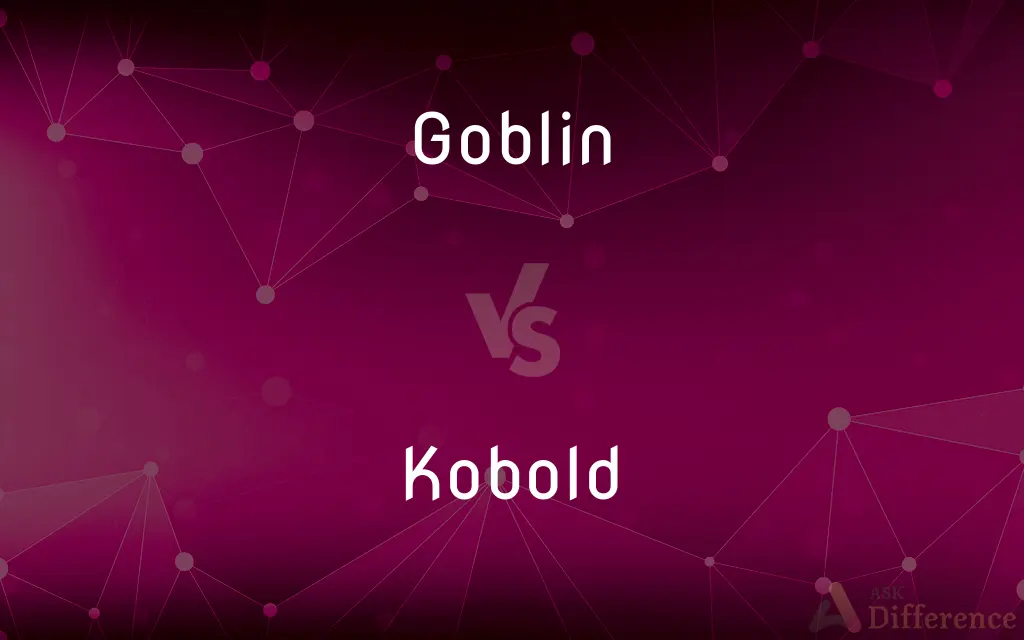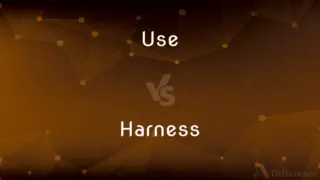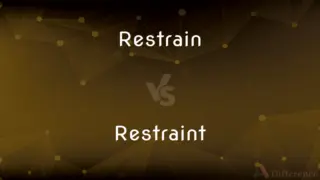Goblin vs. Kobold — What's the Difference?
By Tayyaba Rehman & Urooj Arif — Updated on April 8, 2024
Goblins are mythical, mischievous creatures known for their malevolence, whereas kobolds are Germanic mythological spirits, often tied to a specific place or object.

Difference Between Goblin and Kobold
Table of Contents
ADVERTISEMENT
Key Differences
Goblins, in folklore and fantasy literature, are often depicted as small, grotesque, and malevolent creatures that enjoy causing trouble for humans. They are known for their mischief and are sometimes said to possess magical abilities. Kobolds, originating from Germanic mythology, are also mischievous but are tied to specific places like mines, households, or underground, where they are believed to protect or haunt, depending on their mood.
While goblins are generally considered to be universally malevolent, enjoying the harm they cause to humans and living in dark, hidden places, kobolds have a more nuanced nature. Kobolds can be helpful or harmful: they might aid in household chores or mining tasks while expecting offerings in return, or they might become vengeful if neglected or offended.
In terms of appearance, goblins are frequently depicted as small, green or dark-skinned creatures with pointed ears and sharp teeth, embodying the epitome of their mischievous and wicked nature. On the other hand, kobolds are often visualized in a variety of forms: as small humanoids, animals, or even as flames. Their appearance can change depending on the story or the region’s folklore.
Goblins are a staple in many fantasy universes, where they serve as common foes for heroes to overcome, often found in dungeons or serving darker powers. Kobolds, while less common in modern fantasy, are sometimes included as clever, magical creatures with a strong connection to the earth and an ability to shape-shift or cast illusions, reflecting their roots in Germanic legends.
Cultural perception of these creatures also differs significantly. Goblins have been integrated into global pop culture, appearing in games, movies, and books as antagonists or comedic relief. Kobolds, though well-known in German-speaking countries, have a more localized cultural footprint, often appearing in folklore studies or regional tales.
ADVERTISEMENT
Comparison Chart
Origin
Folklore worldwide
Germanic mythology
Nature
Malevolent, mischievous
Protective or vengeful, tied to a specific place
Appearance
Small, grotesque, often green or dark-skinned
Varied forms: humanoid, animal, or flame
Role in Stories
Antagonists, mischief-makers
Protective spirits, miners' helpers, or household spirits
Cultural Impact
Widespread in global pop culture
More localized, primarily in German-speaking countries
Compare with Definitions
Goblin
Typically grotesque, with green skin, pointed ears, and sharp teeth.
Children often dress up as goblins for Halloween, complete with pointy ears.
Kobold
Known for their ability to take on various forms.
Some believed the kobold could transform into a flame to guide or mislead.
Goblin
Common foes in fantasy games and literature.
The hero’s journey involved clearing the cave of its goblin inhabitants.
Kobold
Can be helpful or harmful, often depending on human actions.
The household kobold would turn mischievous if not given its nightly offering.
Goblin
Often depicted with various magical powers to aid their mischief.
The goblin used its magic to vanish before being caught.
Kobold
Central to German folklore, symbolizing protection or vengeance.
Folk tales often caution against offending the kobold lest disaster strikes.
Goblin
Small, malevolent beings known for causing trouble and harm.
The villagers whispered tales of goblins lurking in the dark forest.
Kobold
Spirits associated with a specific place, such as mines or households.
The miners respected the kobold, believing it brought them good fortune.
Goblin
Appear across various media as antagonists or comedic characters.
The film featured a goblin character that, despite its fearsome appearance, provided comic relief.
Kobold
Less common in global fantasy, but appears in role-playing games and regional tales.
In the game, the kobold was a tricky opponent, using illusions to protect its treasure.
Goblin
A goblin is a monstrous creature that appears in the folklore of multiple European cultures, first attested in stories from the Middle Ages. They are ascribed various and conflicting abilities, temperaments and appearances depending on the story and country of origin.
Kobold
A kobold (occasionally cobold) is a sprite stemming from Germanic mythology and surviving into modern times in German folklore. Although usually invisible, a kobold can materialize in the form of an animal, a fire, a human being, and a candle.
Goblin
A grotesque elfin creature of folklore, thought to work mischief or evil.
Kobold
An often mischievous household elf in German folklore.
Goblin
One of various hostile supernatural creatures, now especially (fantasy literature) a malevolent and grotesque diminutive humanoid, often associated with orcs or trolls.
Kobold
A gnome that haunts underground places in German folklore.
Goblin
An evil or mischievous spirit; a playful or malicious elf; a frightful phantom; a gnome.
To whom the goblin, full of wrath, replied.
Kobold
(German mythology) An ambivalent, sometimes vindictive, spirit that is capable of materialising as an object or human, often a child; a sprite.
Goblin
(folklore) a small grotesque supernatural creature that makes trouble for human beings
Kobold
(German folklore) A mischievous elf or goblin, or one connected (and helpful) to a family or household.
Kobold
(fantasy literature) One of a diminutive and usually malevolent race of beings.
Kobold
A kind of domestic spirit in German mythology, corresponding to the Scottish brownie and the English Robin Goodfellow.
Common Curiosities
How do goblins and kobolds differ in appearance?
Goblins are often depicted with green skin, pointed ears, and sharp teeth, whereas kobolds' appearances can vary widely, including humanoid, animal, or even flame forms.
What is a goblin?
A goblin is a mythical creature known for its malevolence and mischievous nature, often depicted as small and grotesque.
Can kobolds be helpful?
Yes, kobolds can be helpful, especially in folklore where they are seen aiding in household chores or mining, provided they are respected and offered tribute.
Are goblins found in modern entertainment?
Yes, goblins are prevalent in modern entertainment, including movies, video games, and literature, often serving as antagonists or sources of humor.
Where do kobolds originate from?
Kobolds originate from Germanic mythology and are particularly associated with German folklore.
Are goblins considered evil?
Goblins are generally considered malevolent and harmful, delighting in causing trouble for humans.
What role do kobolds play in stories?
Kobolds are typically portrayed as protective spirits of a place, who can become helpful or vengeful based on their treatment by humans.
How are kobolds depicted in video games?
In video games, kobolds may be depicted as cunning creatures with a strong connection to magic or the earth, often as miners or guardians of treasures.
What is a kobold?
A kobold is a spirit from Germanic mythology, known for its connection to specific places like mines or households, and can be either helpful or harmful.
Do goblins have magical powers?
In many stories, goblins are attributed with magical abilities, which they use to cause mischief or escape danger.
Is belief in kobolds still alive today?
While not widely believed in as real entities, kobolds remain a part of cultural folklore and storytelling, especially in Germany.
Can goblins be found outside of European folklore?
Yes, similar creatures to goblins can be found in various cultures around the world, though they may have different names and attributes.
What kind of tasks would a household kobold perform?
A household kobold would perform tasks like cleaning, tidying up, or even guarding the home, as long as it felt respected and received offerings.
Do goblins and kobolds share any similarities?
Both are considered mischievous entities in folklore, but their origins, nature, and roles in stories significantly differ.
Share Your Discovery

Previous Comparison
Use vs. Harness
Next Comparison
Restrain vs. RestraintAuthor Spotlight
Written by
Tayyaba RehmanTayyaba Rehman is a distinguished writer, currently serving as a primary contributor to askdifference.com. As a researcher in semantics and etymology, Tayyaba's passion for the complexity of languages and their distinctions has found a perfect home on the platform. Tayyaba delves into the intricacies of language, distinguishing between commonly confused words and phrases, thereby providing clarity for readers worldwide.
Co-written by
Urooj ArifUrooj is a skilled content writer at Ask Difference, known for her exceptional ability to simplify complex topics into engaging and informative content. With a passion for research and a flair for clear, concise writing, she consistently delivers articles that resonate with our diverse audience.
















































